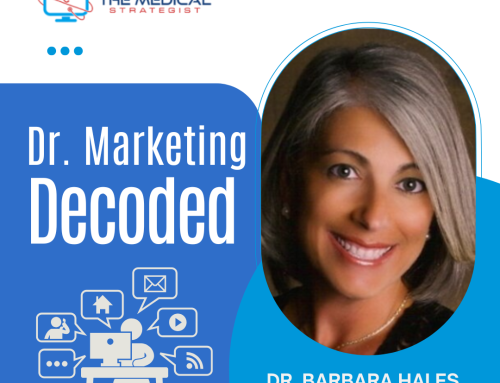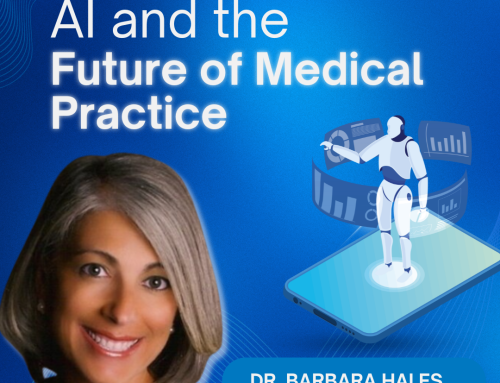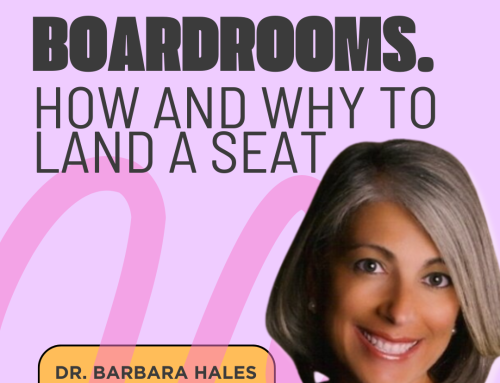Podcast: Play in new window | Download
Subscribe: RSS
In this episode, Barbara and Geoffrey discuss:
- The recent resurgence of storytelling.
- Key techniques for storytelling.
- The importance of making storytelling part of your arsenal.
Key Takeaways:
- Avoid teaching information, details, or tangents within a story. Let the story be the story.
- Use epiphanies and descriptive language to connect to your audience.
- Ted and TedX talks happen all over the world – if you can get in, it’s a game changer and will make you stand out from the crowd.
“Imagination does not need any screen to let it come alive.” — Geoffrey Berwind
Transcription
013 Geoffrey Berwind- Storytelling for Connection
Barbara Hales: Welcome to another episode of marketing tips for doctors. We have a great episode for you today with Geoffrey Berwind. He’s one of the foremost experts on how to use the power of storytelling to make strong connections with your clients and audiences. Jeffrey co-created the award-winning storytelling project called Once Upon a Nation for historic Philadelphia and has coached thousands of authors, business owners and speakers.
He provides workshops and training nationwide and his various clients have included the National Park Service, Kennedy Space Center Visitor Complex, Audubon Society, Vanguard Charitable, Villanova University, and especially the clients of Steve Harrison Bradley’s communications where Jeffrey is their senior coach.
Jeffrey has also coached numerous speakers to prepare them for Tedx talks. The reason why it’s so important for you today, my audience is because having a Tedx talk in your profile tells people that yes, you’re a doctor and that makes you an authority and an expert, but having a Tedx talk also shows you to be an authority in your field above your colleagues down the street, and it is very impressive to most people hearing about it. So welcome today, Jeffrey.
Geoffrey Berwind: Barbara, it’s great to be with you. Thanks for inviting me onto the show.
Barbara Hales: Tell me why is story telling so important as a communicator?
Geoffrey Berwind: Well, of course it’s the oldest thing we do as humans, right? We’ve been doing it for thousands and thousands of years, but why has it re-surged over the last, I’d say 15 years, I would say that’s because of the internet and the 24 seven, in a sense, bombardment of information coming at us through online, through news media and so forth. And as a speaker and as a business owner, yes, you’re expected to give great information, but how are you going to make an emotional connection? How are you going to be known as a person? Who’s the human behind your business?
Storytelling has resurfaced as an essential communications tool. I would say it’s the number one communications tool because at the end of the day, I can buy anything I want online and if I’m going to make a decision competitively, I’m going to buy from somebody I know, like, and trust.
Barbara Hales: Well, absolutely. You know, people want to know who their doctors are. Besides getting the services from them, they want to know them not only as doctors, but as people besides. So, story telling does do that. Tell us what are some key techniques that you would recommend for storytelling?
Geoffrey Berwind: Well, that’s a subject of many, many hours of great discussion, but I’ll give you a quick snapshot. I would say you want to certainly know this is a game changer all by itself, especially for people who are trained as scientists, doctors, academics. You’re expected as a communicator to give great information and data and statistics. However, storytelling inhabits at different parts of our brain, and somebody listening to you as a communicator, the oldest part of their brain is a story receiving brain. And when I work Barbara with a lot of … I’ve worked with some high-level scientists and some NASA people, et cetera, and engineers, when they realize, oh, I’m making a mess of it because I’m interjecting stories and information into one big mishmash. No wonder I’m not really connecting to my audience.
So technique number one is avoid teaching information, detours, or tangents within a story. Save it. Just let the story be the story knowing that is inhabiting the oldest part of the listener’s brain. I definitely like to see a story lining itself with a certain thing you’re trying to teach, and a great way to do that is to simply say, “Let me share a story with how I discovered that,” and then fill in the blank. So at least the people hearing the story knows has a framework for it.
I would say my two favorite techniques though, if I had to only share two, it’s epiphanies and descriptive language. What do I mean by that? Epiphanies is if you’re using, I help my clients actually develop what I call the why I do what I do story. It’s a story of where you’re coming from as a professional, as a human, and somehow you’re using that story to make that connection. Human to human connection with your listeners, your customers, your clients, your patients. And so, you focus the stories on aha moments, on light bulb moments, epiphanies. Ad you create scenes around them.
As a story teller, and I actually Barbara, I prefer the word story sharer because scientifically we become a community when we share our stories versus let me just tell you my story. You’re creating scenes. You’re taking me back in time when you had you’re ahas and you’re developing that scene, so I’m a fly on the wall. And that’s why you never interrupt the story by saying teaching something or going off onto a tangent. And then that’s tied to the other technique, which is descriptive language.
I believe that there’s this marvelous word out there that makes us distinctly human, and that’s called the imagination. And the imagination does not need any screen to make it come alive. In fact, when I coach my clients as speakers, when they’re using the power of storytelling, I say, “If you’re using a slide deck, and I’m not really fond of slide decks, let it go to black.” Because what you’re doing through descriptive language, you’re bringing the story alive through how you’ll describe things.
So for example, there’s a big difference. Give you a quick example. Let’s just pretend I didn’t sleep well last night. All right, so that’s an idea. Well, it’s an idea. I didn’t sleep well last night, but if I slowed it down just a little bit, if I needed to and said, “You know, I maybe ate a little too much last night and I’m tossing and turning and breaking out in a sweat, and I wake up, the moon is coming through the venetian blinds, I look at my digital clock and those red numbers are glowing, 1:39 AM. I’m like, when will I ever get a good night’s sleep?” So, did I slow down the story? Sure. But did I paint a scene? And Barbara, did you see any of that in your mind’s eye?
Barbara Hales: Yes, absolutely. And Jeffrey you’re so right. You know, studies show that long after people forget facts and statistics, it’s the story that they’ll remember.
Geoffrey Berwind: That’s not accidental. You’re exactly right. In a typical business meeting, they’ve measured, people remember, about 30% will remember the facts, but 66% will remember a story. So a story is not, there’s this phrase out there, which I also dislike, a soft skill. As if the hard skills are more important. Actually, to communicate in your business and your practice and anything is the essential skill. It’s the ultimate skill. And I would propose that storytelling should be part of your arsenal as you try to make this connection to your clients.
Barbara Hales: Yes, absolutely. Because story telling also pulls on our heartstrings. You know, as Maya Angelo once said, “Long after we forget everything else, we will always remember how people made us feel.”
Geoffrey Berwin: Isn’t that beautiful? Yes, exactly. And information, it’s hard to make me feel anything through good information. You’re expected to share your professional information. Of course, we all are. But how you make me feel, we’re human beings. We’re not machines. And in the rise, by the way of AI, of artificial intelligence, we humans darn well better master the things that make us distinctly human.
Barbara Hales: Well, if not, they’ll just confuse us with robots.
Geoffrey Berwind: And we may not come out on the positive side of that confusion.
Barbara Hales: So how does storytelling relate to having a TEDx talk?
Geoffrey Berwind: Yeah, so that’s a broad topic too. And when I coach my clients, I teach them what a TEDx talk is and how to try to get one. It’s not easy. It’s unbelievably competitive. I would say a TED talk, or a TEDx talk, it’s the same thing. TED has been around since the 1980s it’s the gold standard of speakers and hopefully your listeners know that it’s a short talk, used to be around 18 minutes, now it’s 10 to 12 minutes that is filmed in front of a live audience, and heavily curated, prepared well in advance, memorized.
And because it’s so hard to get one and it’s distinctive and these Tedx talks are seen around the world, it’s as you said earlier, it’s quite a credential, not easy to attain, and you will use it on your website and on your communications. If you get to do a TEDx talk, this will lead to other good things as you’re marketing your services of your practice.
So the basic thing about a TED or TEDx talk, I’ll use the words interchangeably. Tedx simply means independently organized TED events. It’s a TED event, but licensed from TED for an independent organizer, and they are organizers all over the world, to do a TED event under the TED guidelines. Now, so a TEDx talk is not dominated by a story typically. It’s dominated by … Their tagline is ideas worth spreading ideas. So a story typically is part of a TEDx talk, but the main focus of a TEDx talk is a distinctive idea.
And they define an idea in one of two ways. Either it’s a brand-new thing, the brand new thing is typically a new piece of art, music, discovery, invention, adventure. But most ideas worth spreading as they would define it, are a new take on a preexisting idea, a new take though, your angle on it tied to your work. It can’t just be, I have an opinion about something and I want to do a TEDx talk, they’re going to say no.
So, what I help my clients figure out is what is their idea that we’re spreading. Needs to be said in one or two sentences. Why are you the one to talk about it? And then we figure out who to apply to. There’s organizers everywhere, but they don’t all take applications some it’s by invitation only. And then you prepare to do the talk, you do the talk and then you market the talk. So it’s a big topic, but what a credential. A lot of work, but it’s like getting on Oprah or getting on MSNBC, it may be even bigger because it’s seen in almost 200 countries.
Barbara Hales: Not only that, but people know who you are and they say, “That’s the doctor that I learned such and such information from the TEDx talk.” And that almost supersedes all of the professional work that they’ve done up until that point.
Geoffrey Berwind: It really does. And is of equal weight minimally because today, and I mean this with high respect, but people aren’t really paying attention to all the initials next to your name. What they are paying attention to is, are you a great communicator? Have you done a TED talk? Have you been on major media? And you know people will go to your website, they’ll buy your book if you have a book out, they’ll study and if they are shopping, comparing apples and apples, if somebody has done a TEDx talk, they’re going to go for you. Higher fees could be charged, people who do a TEDx talk can get invited to do keynotes and conferences.
In fact, my first TEDx client is a doctor who lost her own sister from medical error, and I worked with her and her TEDx talk. She got accepted by TEDx Fargo, which is a big organizer, and she did the talk, and the university hospital that originally would not talk to her after the mistake happened, once her TEDx talk came out, all of a sudden they’re talking to her and then she’s not getting paid to be a speaker. And so, these things are game changers. So there’s a whole process. It is complicated, it’s super competitive, but it distinctivizes you in a very unusual way.
Barbara Hales: Do they do TED talks all over the world?
Geoffrey Berwind: All over the world. And you can go to ted.com and you could see a map of organizers that are active. The way it works is an organizer, you don’t get paid, they don’t get paid. So they have to be all volunteer. They have to be licensed by TED to do it the right way with the TED red carpet and the TED logo and follow all the rules and make sure people do a good job. And it’s a new talk, not a talk they’ve done a thousand times. And then once you’re filmed as a TEDx speaker, the organizer will send that video to the TED organization itself for review and approval. And if they approve it as they probably will, they’re going to post it onto their website and also onto YouTube. And it’s up there as long as there’s YouTube.
Some people have tens of thousands, hundreds of thousands, even millions of views. So, it’s distinctive. And again, it’s a short talk. Today, not more than 10 minutes about a single idea, which you explore and maybe you support by some stories, but also by data or statistics. You intrigue us, you inform us. How is it an idea that’s going to change the world for the better?
Barbara Hales: So, listeners get ahold of this no matter where you’re located and where you’re listening, no matter whether you’re in the United States or anywhere abroad, you can find a Tedx talk geographically to apply to.
Geoffrey Berwind: That’s exactly right. You could certainly just Google TEDx and your city. You don’t have to apply where you live, but you can start there. But you could start by going to ted.com and on the page at the top it says attend. There’s a dropdown. And the second dropdown says TEDx events. And on that page you will see updated daily, lists of organizers all over the world. Now, it’s more complicated than that to figure out whether they take applications or not, but that’s a way to discover where they are. And there’s hundreds and thousands all over the world.
Barbara Hales: That’s great. So could you please tell our audience, Jeffrey, how they could reach you in case they would be interested in training under you?
Geoffrey Berwind: Absolutely. I’d be honored. I work with Steve Harrison who is one of the foremost experts who helps authors and speakers and entrepreneurs get publicity and marketing, I’m his senior coach and I work with hundreds and hundreds of his clients. And one of the programs, the program I lead up actually, is the unforgettable speaker training program and you could check it out at unforgettablespeakertraining.com. You get lots of time with me, and I can help you in whatever parts of speaking, storytelling, or TEDx you need assistance with.
Barbara Hales: Okay. Well listeners, I hope you caught that because Geoffrey Berwind is a fantastic mentor and you would do well by having him as your coach.
Geoffrey Berwind: Well, thank you Barbara, and thanks for the work you do and just helping marketing for doctors and just really appreciate being invited onto your show.
Barbara Hales: Well, thank you so much for sharing your time with us today.
Geoffrey Berwind: It’s a pleasure.
Connect with Geoffrey Berwind:
Website: UnforgettableSpeakerTraining.com
Connect with Barbara Hales:
Twitter: @DrBarbaraHales
Facebook: facebook.com/theMedicalStrategist
Business website:www.TheMedicalStrategist.com
Show website: www.MarketingTipsForDoctors.com
Email: Barbara@TheMedicalStrategist.com
Books:
YouTube: TheMedicalStrategist
LinkedIn: www.linkedin.com/in/barbarahales



